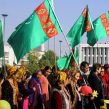
Unpublished Census Provides Rare and Unvarnished Look at Turkmenistan
Publication: Eurasia Daily Monitor Volume: 12 Issue: 26
By:

Turkmenistan is perhaps the most opaque country of all the post-Soviet states, with the government exercising tight control over almost all information and publishing only those statistical figures that serve Ashgabat’s interests. That makes the results of a census conducted in December 2012 especially interesting and important as the basis for considering what is actually taking place in that Central Asian country (Chrono-tm.org, February 3).
The 2012 census, previously unreleased by the government, was recently published in part on a Turkmenistani Internet portal. Turkmenistan’s last census that was more or less fully reported dates back to some 20 years ago. Moreover, the country’s leaders and officials have repeatedly provided inconsistent information about both the total number of people in the republic and the ethnic composition of its population. Sometimes the authorities have boosted the share of Turkmenistan’s ethnic Turkmens; other times, their reported figures increased the number of non-Turkmens. Frequently, Turkmenistani statistics have shifted the balance between ethnic Russians and other non-Turkmens in one direction or the other.
Now, some officials of the Turkmenistan State Committee on Statistics, speaking on condition of anonymity, have provided Chrono-tm.org with a selection of census data from the December 2012 enumeration. These figures show that the number of residents of the republic on the day of the census was 4.75 million, far fewer than the government had claimed over most of the last decade. Reportedly, 42,000 Turkmenistanis were studying abroad, 1,000 were working in embassies or other government agencies abroad, and approximately 82,000 were guest workers.
The officially unpublished census data also shows that the numbers of men and women in Turkmenistan are almost equal. It also claims that 100 percent of the men and 90 percent of the women of working age are working, figures that Chrono-tm.org says are almost certainly false given the high level of unemployment that anyone can see “with an unaided eye.”
The 2012 census found that 85.6 percent of the population consisted of ethnic Turkmens, far fewer than the government has claimed earlier. Of the remainder, 5.8 percent were ethnic Uzbeks and 5.1 percent were ethnic Russians—both figures at variance with earlier reports as well. Chrono-tm.org says that its source in the State Committee said that these figures, as well as the total population of the country, have likely since changed, with the percentage of ethnic Turkmens higher and the republic’s total population now significantly above five million.
One indication that Turkmenistan’s officials are unlikely to feel compelled to use the census figures, the portal said, is that in January of this year, Turkmenistani diplomats at a United Nations conference in Geneva said that ethnic Uzbeks formed somewhat fewer than 9 percent, ethnic Russians made up 2.2 percent, and ethnic Kazakhs—0.4 percent. Overstating the number of Uzbeks and understating the share of ethnic Russians appears to reflect the political needs of Ashgabat rather than the facts on the ground. Earlier, in 2001, Turkmenistan’s officials said that ethnic Turkmens formed 91 percent of the population, ethnic Uzbeks—3 percent, and ethnic Russians—2 percent.
But according to the same source, the 2012 census found some information that almost certainly will never be released: 4 percent of the population apparently owns 45 percent of the wealth of the country, but 60 percent of families, the parents of which are under 30, do not own their own homes. Again, these figures contradict what the government of Turkmenistan has repeatedly claimed.
The total size of the population and its ethnic composition are the two most sensitive numbers and the ones officials have routinely distorted in the past. The authorities have generally been able to cover up these distortions by simply not providing any of the data collected by the State Statistical Committee or even by falsifying the data the institution collects and collates.
The total population of Turkmenistan more than doubled between 1989 and 2001, although it appears to have largely stabilized since that time, with continuing increases in the number of ethnic Turkmens balanced by the outmigration of other groups and of ethnic Russians in particular. During that 12-year period, ethnic Turkmens increased from 2.5 million to 4.9 million, while the number of ethnic Russians fell by almost two-thirds, from 334,000 at the end of Soviet times to slightly more than 100,000 fifteen years ago (Demoscope.ru, accessed February 10).
The rise and fall of the local ethnic-Russian population over the last 125 years reflects the outcome of the competition between the needs of the Russian and Soviet states on the one hand, and the demographic boom among the Turkmens, on the other. In 1897, ethnic Russians (who were grouped with Ukrainians and Belarusians in that enumeration) formed 8.7 percent of the population of what became Turkmenistan. By 1939, their share in the population had risen to 18.6 percent while that of the Turkmens had fallen to 59.2 percent. But by 1989, the ethnic Russians’ share in the population had fallen to 9.5 percent, while that of the Turkmens had risen to 72 percent, largely because of a dramatically higher birthrate. Since 1991, the Russian share has fallen still further because of Russian flight as well.
Turkmenistan’s domestic political situation, and even the details of its national make-up, have long been shrouded in mystery to most outside observers. Yet, as the extensively closed regime of former president Saparmurat Niyazov fades into memory, the country’s government will continue to cautiously and gradually open itself up to the local population and the rest of the world.




